by Terry Messman

Shelley Douglass (left with microphone) speaking out against the deaths of children caused by U.S. sanctions in Iraq; courtesy thestreetspirit.org
“The whole point of the arms race is to protect what we have that really isn’t justifiably ours. As long as we remain complicit with that, then to that extent we’re complicit with weapons like the Trident. So we were trying to withdraw our cooperation as much as we could.” Shelley Douglass
Street Spirit: You’ve devoted many years of your life to nonviolent resistance to nuclear weapons. When did you first become involved in the Ground Zero Center for Nonviolent Action?
Shelley Douglass: The Pacific Life Community was the original group that started the Trident campaign. The crucial thing about it was that the whistle was blown on the Trident by the man that was designing it, Robert Aldridge. Jim and I had met Bob Aldridge when we were in the middle of the Hickham trial in Honolulu. [Editor: Jim Douglass, Jim Albertini and Chuck Julie were on trial for an act of civil disobedience at Hickam Air Force Base in protest of the Vietnam War. TM]
We didn’t know very much about Bob Aldridge until he came to visit us at our home in Hedley, British Columbia, several years later. He told us a very moving story about how he had spent his life designing nuclear weapons, and he and his whole family had made the decision that he should resign from his job for reasons of conscience. They had taken a tremendous cut in income. They had 10 kids, and his wife had gone back to work, and the whole family was behind this decision.
Read the rest of this article »
by Terry Messman
“You age and die on death row if they don’t electrocute you or murder you in some other way. One of the men had a stroke and had to be taken care of. Leroy was one of the major caregivers for him. Leroy was never an angel, but he became a very compassionate person.” Shelley Douglass
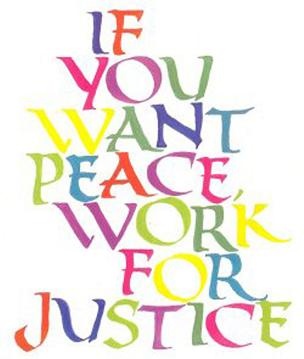
Poster art courtesy thestreetspirit.org
Street Spirit: You described in Part 1 how you first became inspired by the Catholic Worker while in college. How did you begin Mary’s House in Birmingham?
Shelley Douglass: When we moved here to Birmingham, we were sort of delegated by Ground Zero to watch trains, but after we had been here for two years we realized there were no more trains to watch. So we had to make the choice: Do we go back to Ground Zero, or do we stay here, and if we stay here, what are we here for? That just kind of fit in with my always having wanted to do a Catholic Worker. So we decided that we would do a Catholic Worker, even though we had no money. I mean, you never have any money when you start a Catholic Worker.
Spirit: Dorothy Day described one of the primary missions of the Catholic Worker as providing houses of hospitality. Does Mary’s House offer hospitality?
Douglass: Well, physically, Mary’s House is a big old house, kind of like many Catholic Worker houses. It was built in 1920 in the Ensley area of Birmingham, which used to be a big steel and brick making area. It’s got four bedrooms, one of which I sleep in, and three of them we use as hospitality, primarily for families or single women. People come and stay while they get on their feet. It’s kind of like a big family house.
Read the rest of this article »
by Beverly Woodward
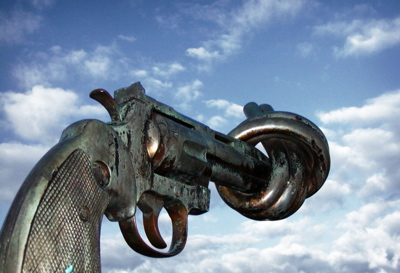
Nonviolence sculpture by Carl Fredrik Reuterswärd; courtesy en.wikipedia.org
Editor’s Preface: This unpublished essay was presented at an international conference of peace researchers and activists (July 1-6, 1975, Noordwijkerhout, Netherlands), and continues our series of rediscoveries from the War Resisters’ International archive. For further notes on the text, the archival reference and a biographical note about Woodward please see the end. JG
The term “nonviolence” has been a controversial one. Over the years many have objected to it on the grounds that it is negative rather than positive in substance and therefore does not hold out a vision of what one is for rather than what one is against. The objection is valid, but it overlooks one benefit obtained by the use of this term. When we speak of nonviolence we highlight the fact that a peaceful world cannot be attained without struggle and resistance. Nonviolence is anti-violence and must be, since violence, unfortunately, is woven into the fabric of our lives. To obtain peace we must resist violence. To resist violence is to resist deeply rooted inclinations, habits, customs, laws, and institutions.
Read the rest of this article »
by Bhikhu Parekh
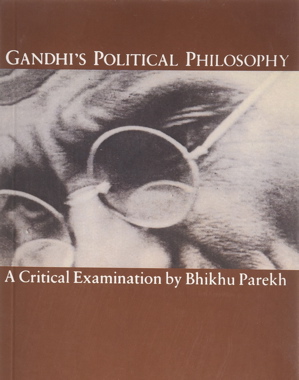
Dust jacket art courtesy Palgrave Macmillan; palgrave.com
Marxist interpretations of Gandhi contain important and valid insights that are, however, oversimplified; the picture is more complex and messy. The Congress under Gandhi’s leadership was not a party of the upper middle class. Although it did not reject the institution of private property, it assigned the State a considerable regulative and redistributive role, stressed the pursuit of social justice, and was not an advocate of unrestrained capitalism. To say, as some Marxists do, that since Congress did not advocate the abolition of the capitalist mode of production it was therefore a spokesman for capitalism, is to take too simple-minded a comment on the range of political possibilities open to radicals. Congress was essentially a middle class party, constantly reaching out to new groups and interests on both sides of the economic consensus in a way that was neither wholly capitalist nor fully socialist and not heavily biased towards a particular group. Rightwing and leftwing ideas grew up around its petit bourgeois core and both shaped and were in turn shaped by it. Nehru put the point well: “Even our more reactionary people are not so rigid in their reactions as they are probably in Europe and America. And even our most advanced people are somehow influenced by Gandhiji. He created connecting links between conflicting interests.”
The flow of political influence and the process of moral sensitisation between the different groups proceeded in both directions. The haute bourgeoisie influenced the Congress and enjoyed a measure of political power as the Marxists argue, but they were also required to recognise the legitimate demands of the poor and the oppressed. The middle and upper class peasantry did from time to time link up with the bourgeoisie, but it also retained its independence, threw up leaders of status and class loyalty, and influenced Congress policies on important matters. Many of these leaders were not created by or in any way indebted to the bourgeoisie, and had come to power on the basis of their personal sacrifices and leadership of peasant struggles. They had constituencies which they could not lightly ignore and whose interests they could not subordinate to those of some other class. The Marxist commentators exaggerate the situation when they claim that Gandhi delivered the peasantry to the capitalists.
Read the rest of this article »
by George Lakey
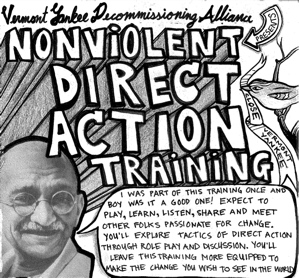
Poster art courtesy wrongkindofgreen.org
Editor’s Preface: This previously unpublished essay was a paper presented at the International Conference of Peace Researchers and Peace Activists (Noordwijkerhout, Netherlands, July 1-6 1975), and is another in our series of important discoveries from the War Resisters’ International archive. Please see the notes at the end for archival information, and for a note about George Lakey. JG
Training for peace action is a fairly new phenomenon. By training I mean the systematic sharing of skills and knowledge. Activists in former years could learn by apprenticing themselves to experienced leaders, or could pay special attention to those conferences and institutes featuring nonviolent organizers. But there was nowhere they could go to get systematic, long-term training.
The burst of nonviolent action in the nineteen-sixties stimulated people in a number of countries to seek to remedy this. In 1965 the first international conference on training for nonviolent action was held in Perugia, Italy, by War Resisters’ International. Activists came from as far away as India and the U.S. to compare notes on training experience.
Read the rest of this article »
by A. J. Muste

Poster quote courtesy griid.org
This article is in the first instance an appeal to those, Negro and white, who are taking part in the movement for civil rights in the United States today in 1964. It is an appeal that in considering how to deal with the agonizing and complicated problems which now beset it the emphasis shall be on nonviolence, i.e. on maintaining the spirit of nonviolence in the movement and in devising apt and imaginative applications of a basically nonviolent strategy.
During the long hot summer of 1964, about which we had been warned or with which we had been threatened, the violence and tension were focused largely on Mississippi where three young men who volunteered to work in the Council of Federated Organizations (COFO)campaign for voter registration and related objectives simply disappeared. It was in Mississippi that Medgar W. Evers, the devoted and highly respected organizer of the National Association for the Advancement of Colored People (N.A.A.C.P.), was brutally assassinated. No one has been convicted of that crime in the courts of that state. It was in Jackson, Mississippi, that the widow of Medgar Evers at his memorial service said to her fellow Negroes and fellow workers, “We must not hate; we must love”. What I am trying to say in what follows is that this statement must be the light that guides the movement in the dark passages and the motto on its banners as it moves into the light.
Read the rest of this article »
by Theodore Olson
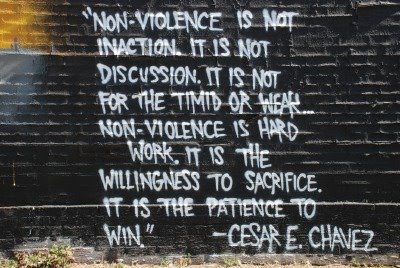
Poster art courtesy occupysantacruz.org
Editor’s Preface: This unpublished essay was a paper presented at the study conference Training in Nonviolence (Perugia, Italy, 13-20 August 1965) under the joint auspices of War Resisters’ International, and is another in our series of rediscoveries from the WRI archive. Please see the notes at the end for further archival references, a link to a pdf scan of the original, and biographical information about the author. JG
By nonviolent training we mean conscious attempts, in the context of teaching and learning, to impart historical experience, general concepts, technical skills and personal experience in how to act effectively and nonviolently in conflict situations. By “nonviolently” we mean to stress programmatic or active nonviolence, as exemplified by, but not restricted to, social action struggles: for example, Gandhi’s actions in India and that of the peace and civil rights activists in the United States.
Read the rest of this article »
by Theodor Ebert
Editor’s Preface: This unpublished essay, by an eminent Christian pacifist and theorist, was a paper presented at the Study Conference on Nonviolent Solutions of Conflict with Special Reference to Germany and Berlin. It was held in Offenbach, Germany, in August 1964 under the joint auspices of War Resisters’ International, and is another in our series of rediscoveries from the WRI archive. Please see the notes at the end for further archival references and biographical information about the author. JG

Image courtesy vjai.com
In March 1964 a collection of articles was published in London under the title ‘Civilian Defence’ in which Adam Roberts, Jerome Frank, Arne Naess and Gene Sharp discussed the possibilities of meeting invasion or coup d’état by nonviolent resistance. Adam Roberts in his introductory contribution states, ‘All the authors of the articles in this booklet consider that nonviolent action should be judged not in terms of a doctrine, which one may accept or reject, but as a technique, the potentialities of which in particular situations demand the most rigorous and careful study.’
It should be the task of science, even at the risk of shocking public opinion and making ‘creative misunderstandings’ more difficult, to reveal the doctrinal background of such a technique, i.e. to explain the ideas of the leaders of nonviolent resistance campaigns who, in deference to the outside world, pretended to be mere technicians of nonviolent action or who, at best, called themselves ‘practical idealists’ with the accent on ‘practical’.
Read the rest of this article »
by Melanie Nakashian
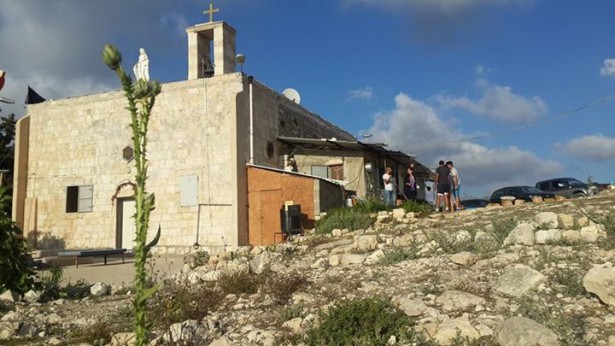
St. Mary’s church, Iqrit; courtesy wagingnonviolence.org
Editor’s Preface: The story of the decades-long nonviolent protest in the village of Iqrit, northern Israel, is one we have previously covered, and can be found at this link. Indeed, our previous article, from our WRI research project, was written in 1974, to cover a nonviolent protest that had already been going on for several years. That the inhabitants have resorted to the courts and symbolic acts of protest such as planting trees and gardens, but have remained nonviolent, is one of the more remarkable stories of contemporary nonviolent protest. JG
Among the hundreds of Palestinian villages that were evacuated between 1947 and 1951, there is one whose descendants are actually getting close to fulfilling their right of return. In an unprecedented case, the demolished Christian village of Iqrit should soon be connected to Israel’s electricity grid. This comes just as a group of Iqrit’s young descendants mark three years, this August 5 [2015], of continuously inhabiting the church in their otherwise destroyed village.
Read the rest of this article »
by Stephen Zunes and Noor Al-Haidary
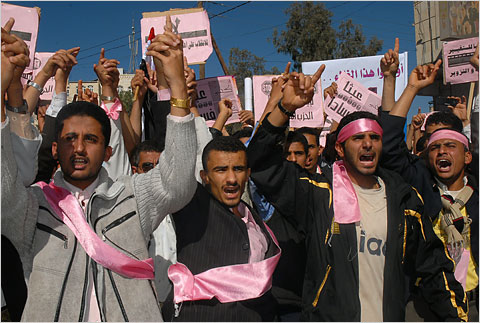
Yemeni protesters wear pink as symbol of nonviolence; courtesy went2thebridge.blogspot.nl
As with the 2011 uprising against the Saleh regime in Yemen four years ago, an unarmed civil society movement is now (April 2015) rising up to challenge the Huthi militia. While media coverage of the tragic situation unfolding in Yemen in recent months has focused on armed clashes and other violence, there has also been widespread and ongoing nonviolent civil resistance employed by a number of different actors. In fact, the most significant setbacks to the Huthi militia in their march southward across the country in recent months have come not from the remnants of the Yemeni army or Saudi air strikes, but from massive resistance by unarmed civilians which has thus far prevented their capture of Taiz, the country’s third largest city, and other urban areas. The resistance efforts have also pressed the Huthi to withdraw their forces from a number of previously held areas, including universities, residential neighborhoods, and even military bases. This kind of nonviolent resistance by ordinary people is remarkable, but it is not new in Yemen.
Read the rest of this article »














